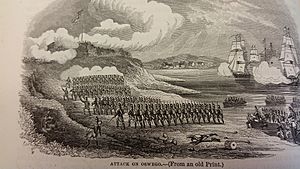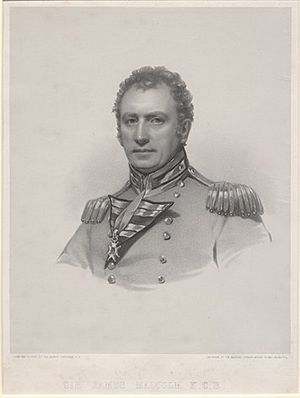Battle of Fort Oswego (1814) facts for kids
Quick facts for kids Battle of Fort Oswego |
|||||||
|---|---|---|---|---|---|---|---|
| Part of the War of 1812 | |||||||
 The attack on Fort Oswego, 1814. |
|||||||
|
|||||||
| Belligerents | |||||||
| Commanders and leaders | |||||||
| James Lucas Yeo Karl Viktor Fischer William Mulcaster |
George Mitchell | ||||||
| Strength | |||||||
| 550 soldiers 400 marines 200 sailors 8 warships |
242 regulars 25 U.S. Navy 200 militia |
||||||
| Casualties and losses | |||||||
| 17-18 killed 63-69 wounded Total: 80-87 |
6-21 killed 38 wounded 25-60 captured Total: 69-119 |
||||||
The Battle of Fort Oswego was a military attack by the British on Fort Ontario and the village of Oswego, New York. It happened on May 6, 1814, during the War of 1812. The British managed to achieve some of their goals in this raid.
Why the Battle Happened
In early 1814, while Lake Ontario was frozen, both the British and American navies were busy building new warships. Each side was trying to build two large frigates. The British, led by Commodore Sir James Lucas Yeo, finished their ships first. This gave them a temporary advantage on the lake.
The American commander, Commodore Isaac Chauncey, was also building powerful frigates. Once his ships were ready, the British would no longer be stronger.
Sir Gordon Drummond, a British general, wanted to attack the main American naval base at Sackets Harbor, New York. However, the Governor General, Sir George Prevost, wouldn't send enough extra soldiers.
So, Drummond and Yeo decided to attack a smaller target: Fort Ontario. This fort and the nearby village of Oswego, New York were very important. They were a key stop on the American supply route from New York City. Supplies like weapons, food, and other goods traveled up the Mohawk River and across Lake Oneida to Oswego. From there, they went across Lake Ontario to Sackett's Harbor.
The British knew that Fort Ontario had only about 290 regular soldiers. They also believed that more than thirty heavy guns, meant for Chauncey's new ships, were waiting at Oswego. By capturing Oswego, the British hoped to seize these guns. This would help them keep their advantage over the American navy on the lake.
The Attack Begins
Commodore Yeo's ships picked up the landing force and left Kingston on May 3. They reached Oswego early on May 5. The soldiers got ready to land, but a strong wind made it impossible for the British ships to get close enough to fire their cannons and support the landing. That evening, a storm forced the British ships to pull back for the night.
The British ships returned to Oswego the next morning, May 6, around eleven o'clock. The landing began. The landing force included soldiers from the 2nd Battalion, Royal Marines, led by Lieutenant Colonel James Malcolm. There were also soldiers from the Glengarry Light Infantry and the Regiment de Watteville. About 200 sailors, armed with pikes, also joined the attack. Lieutenant Colonel Victor Fischer was in charge of the landing.
The American defenders were led by Major George Edward Mitchell. His force included 242 soldiers from the 3rd U.S. Regiment of Artillery, 25 U.S. Navy sailors, and about 200 local militia. The fort itself was not in good condition. However, the delay in the British landing allowed the Americans to move more cannons to face the lake. They had five guns in total in the fort.
While two large British ships, HMS Prince Regent and Princess Charlotte, fired at the fort, smaller British ships fired at the woods and beaches. The British troops landed around two o'clock. Many soldiers landed in deep water, and their gunpowder got wet, making their guns useless. Even so, they attached their bayonets to their rifles and moved forward under heavy fire.
The Glengarry Light Infantry cleared the woods to the left, and the sailors attacked the village. The main British force charged directly at the fort. American soldiers outside the fort quickly retreated inside. As the attackers reached the top of the fort's outer slope, the American defenders left the fort and ran away.
Who Was Hurt?
It's a bit tricky to know the exact number of people hurt in the battle. British records show that between 17 and 18 soldiers were killed, and 63 to 69 were wounded. Captain Mulcaster, a British officer, was badly wounded and lost a leg.
American losses are also hard to count precisely. One report said 6 Americans were killed, 38 wounded, and 25 missing. Another report said 5 killed, 28 wounded, and about 24 prisoners. General Drummond, the British commander, reported capturing about 60 American soldiers, many of whom were wounded.
What Happened After
The British collected many useful supplies from Oswego. They found about 2,400 barrels of flour, pork, salt, bread, and other military items. They also captured a few small ships called schooners. One of these was the USS Growler, which had seven valuable cannons meant for Commodore Chauncey's ships. The Americans had tried to sink the Growler to prevent its capture, but the British managed to raise it.
Lieutenant Phillpotts of the Corps of Royal Engineers then set fire to and destroyed the fort, barracks, and any supplies the British couldn't take with them. The British forces left Oswego around four in the morning on May 7.
The British missed twenty-one more cannons that were still on their way to Oswego. These guns were about 12 miles (19 km) away at Oswego Falls. Instead of going after them, Commodore Yeo decided to block Sackett's Harbor to stop the guns from reaching Chauncey. The Americans tried to move the guns by small boats, but the British intercepted them. Later, British marines and sailors tried to capture these guns in a special attack, but they failed. About 200 British marines and sailors were ambushed and captured at the Battle of Big Sandy Creek.
Once Commodore Chauncey finally received all his guns and prepared his ships, he controlled Lake Ontario from late July 1814 until the end of the year.



